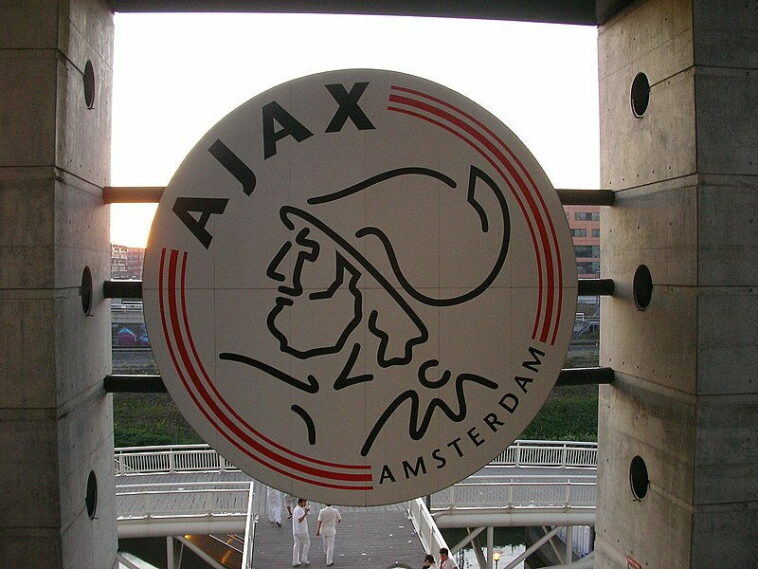Founded on the 18th of March 1900, there was a time when Ajax was a byword for all things attractive about football. Based in the Dutch city of Amsterdam, Ajax plays its football in the Eredivisie, the top-flight league in Holland. It has played in the division ever since its inception in 1956 and is considered to be one of the most successful clubs in the history of the sport.
There are only five clubs that have won all of the major competitions that are offered by UEFA, with Ajax being one of them. In other words, this club is a big deal and taken seriously on the international stage.
Whilst Ajax’s European dominance has fallen away in recent times, the club is still thought of as being European royalty. Some of the names associated with the club are those that are well-known to everyone who knows even a little bit about football.
The likes of Denis Bergkamp, Johan Cruyff and Marco van Basten all made their way into the sport courtesy of the Ajax youth system, whilst 2016 saw the club launch the Ajax Coaching Academy, which is designed to help players and coaches develop thanks to the knowledge offered by the club, influencing the future of the sport.
The History of Ajax

Amsterdamsche Football Club Ajax, to give the team its full name, was established in the Dutch city of Amsterdam on the 18th of March 1900. The founding fathers were Stempel, Carel Reeser and Han Dade, who had formed a club called Football Club Ajax in 1894 that was short-lived in nature.
The club was an amateur one for the first few years of its existence, but in 1911 Jack Kirwan guided it into the highest level of Dutch football at the time. Having played mostly in black (as pictured above), the club was forced to change its colours upon promotion as Sparta Rotterdam already played in its colours.
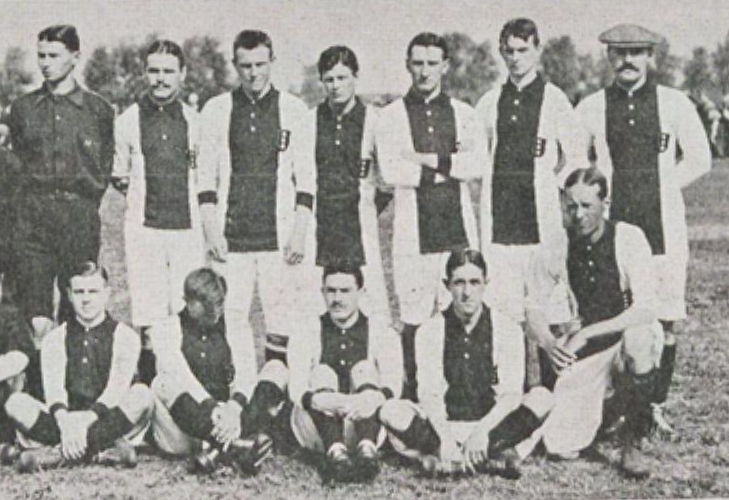
As a result, Ajax started playing in a white kit with a red stripe and white shorts, colours that remain associated with the club to this day. They did well enough for one of their players, Gé Fortgens made it into the Netherlands national team, they were relegated out of the division in 1914. They won the secondary league in both 1915 and 1916 but neither saw them re-promoted thanks to the outbreak of World War One. They did return to the top-flight in 1917 and won the Dutch national cup that year, winning their first title in 1919, when they also went unbeaten.
Major success was enjoyed by Ajax throughout the 1920s and 1930s, with many of the club’s players becoming household names. They were mostly rebuilding during the 1940s, becoming league champions once more in 1947. They also became regional champions in 1950, although they never managed to win the championship.
The season was most notable for a match against SC Heerenveen, in which Ajax went 5-1 up only to end up losing the match 6-5. They also went 6-0 down to VUC but were able to get themselves back into the game and ended up drawing it 6-6.
Turning Professional In 1955
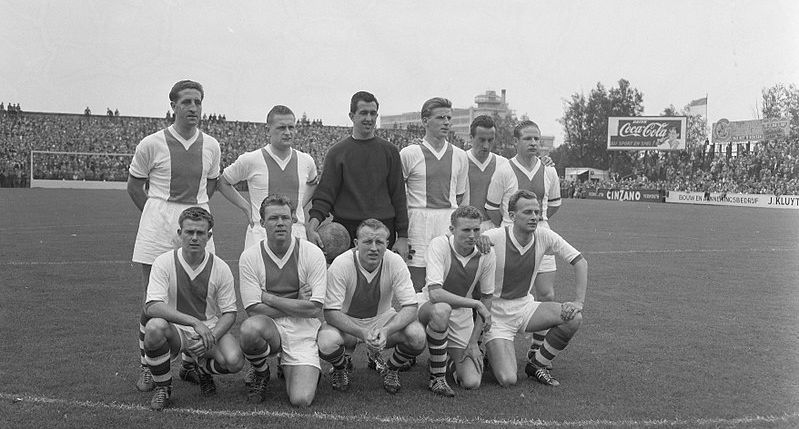
In the Netherlands, football had remained an amateur sport until 1955, which was the point at which professionalism was eventually allowed. Ajax turned professional when they were allowed to, but they remained far from the top as far as the rest of Europe was concerned.
They played a European Cup match against Hungarian side Vasas SC, for example, and lost 4-0. Numerous other European failures followed, including defeat to Norwegian amateur side Frederikstad FK in 1960 and defeat in the European Cup a year later by Újpest FC of Budapest.
The Eredivisie was founded in 1956, with Ajax winning it for the first time in 1957 before repeating the trick three years later. In 1960, the title was decided according to a play-off after them and Feyenoord, their arch rivals, finished level on points.
Ajax won the play-off 5-1 to cement their place as one of the best teams in Holland. Three years later, however, and they missed out on the title having lost 5-2 to PSV, signalling the start of a period of decline for the Amsterdam-based side. By the time the 1964-1965 season came around, they were battling relegation.
The ‘Total Football’ Era
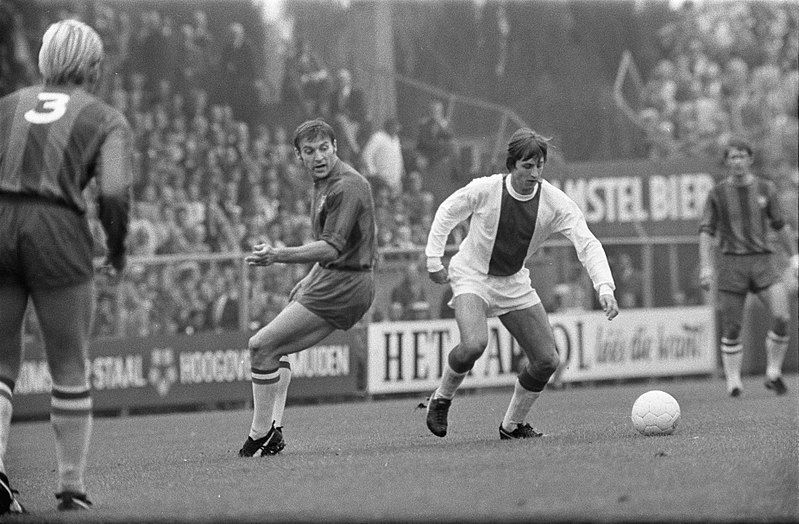
Rinus Michels, a former player, replaced Vic Buckingham as manager and led the club to a mid-table spot. It was during a 3-1 loss to GVAV that Michels introduced a young player called Johan Cruyff, who would go on to define not just the history of Ajax but to change the face of football in general.
Michels began something of a revolution in Amsterdam, building a side around a vision of ‘total football’. Any players that he felt were not good enough for what he was trying to achieve were sacrificed, including a defender who scored an own goal in the quarter-final of the European Cup in 1967.
That came after Ajax had defeated Beşiktaş and beaten English side Liverpool 5-1 in earlier rounds. They won the Eredivisie championship in dominant style in 1966 and then again in 1967, boasting a seemingly unstoppable attack. They scored 122 goals, which remains a national record, with 33 of them being scored by 20-year-old Johan Cruyff.
That was also the year that the club won the double for the first time, defeating NAC Breda in the cup final. They won the league again in 1968, adding to it a trip to the final of the European Cup to play against Madrid in Milan.
It was something of a lesson for the Dutch, however. Milan were known for their strong defence and excellent counter-attacking system, putting Ajax to the sword in a 4-1 win. It led to another period of rebuilding for the club, with well-established players departing in order to be replaced by fresh blood. That included the arrival of the national top scorer in Dick van Dijk, whilst second team player Ruud Krol was promoted into the first team.
It proved to be excellent work by those in charge, with Ajax winning 27 out of their 34 games in the 1969-1970 league championship.
The First European Cup Win In 1971
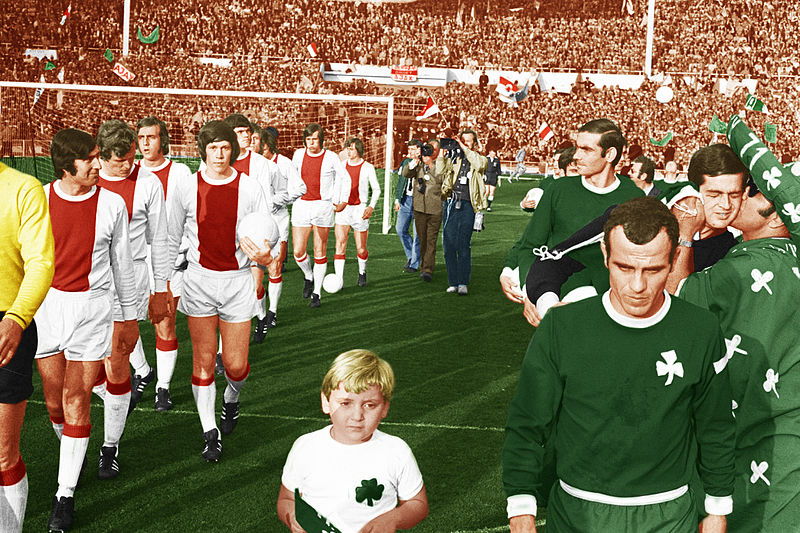
The 1969-1970 season was an excellent one for Ajax, winning the title, but their celebrations were muted somewhat by the fact that Feyenoord won the European Cup. It was the one competition that they hadn’t yet managed to win, so seeing their rivals win it stung somewhat.
If it was to be used as inspiration then it absolutely worked, with the Amsterdam side heading into the 1970-1971 campaign with a determination to take the trophy off their rivals. They ended up missing out on the Eredivisie title to Feyenoord, but they won the European Cup for the first time.
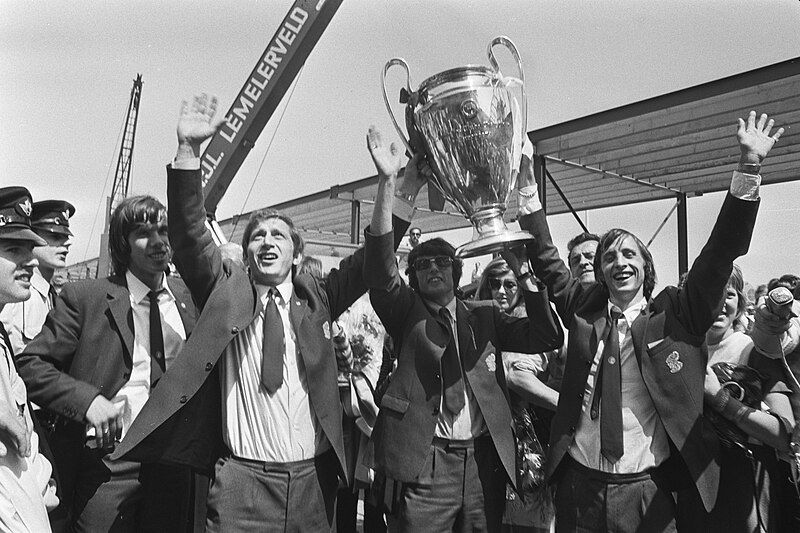
Having lost two finals in the competition previously, captain Velibor Vasović finally got to hoist the European Cup above his head. In the years that followed, the Dutch side established itself as the best team on the continent, with changes behind the scenes making no difference to their success.
Becoming European Royalty
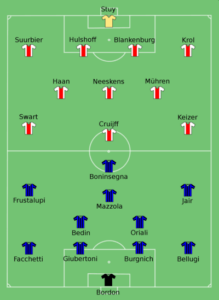
In 1972, Ajax proved that they were one of the best teams in the world by completed a treble of the European Cup, Dutch National Championship and the KNVB Cup, also adding the Intercontinental Cup.
A year later they nearly repeated the trick, winning the European Cup for a third success season and adding the Eredivisie, but they failed to win the KNVB Cup. Even so, it was a period of dominance that has rarely been seen in Europe, with Ajax defeating Inter Milan in the European Cup final in 1972 and another Italian opposition in the form of Juventus in 1973.
In order to be awarded the European Cup on a permanent basis, a club has to either win it five times or else win it three times in succession. Ajax did the latter thanks to their 1973 victory, meaning that they are one of only a select number of clubs that have seen old big ears land in their trophy cabinet permanently.
Sitting alongside Real Madrid, Liverpool and Bayern Munich is proof positive that the Dutch team is European royalty. In 2009, UEFA re-wrote the rules to say that the trophy will remain their property, so the clubs that have been given it permanently is now locked in.
A Period of Disappointment After Cruyff Leaves
In 1973, Johan Cruyff left Ajax in order to sign for Spanish side Barcelona. It signalled the start of a downturn in fortunes for the club, ending the reign of the players that had become known as the ’12 Apostles’. Heinz Stuy, Wim Suurbier, Barry Hulshoff, Horst Blankenburg, Ruud Krol, Arie Haan, Johan Neeskens, Gerrie Mühren, Sjaak Swart, Johan Cruyff and Piet Keizer usually made up the club’s starting 11, with Ruud Suurendonk being the 12th man until 1972 when Johnny Rep took on the role.
A defeat to CSKA Sofia in the European Cup late in 1973 also signalled the end of ‘Total Football’.
The style of play that Ajax had propagated became well-known to fans of virtually every generation, not least of all because the Dutch national team copied it during the 1974 World Cup and made it to the final as a result. They lost to West Germany, which, combined with Ajax’s own decline, resulted in the ‘Total Football’ era coming to an end.
Years after the fact, the Ajax manager at the time, Tomislav Ivić, dubbed the period ‘Gloria Ajax’, which is a neat encapsulation of the club’s period at the very top of European football, being untouchable for more than three years.
Getting Back to the Top With Louis van Gaal
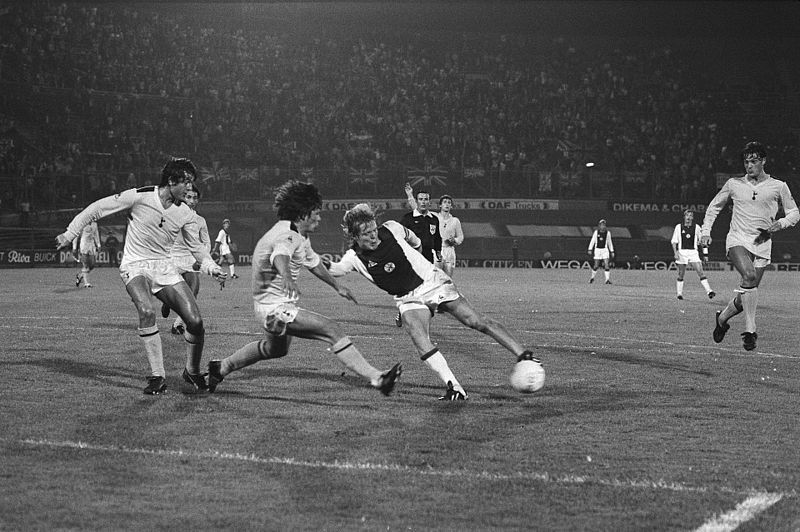
After their period of disappointment, Ajax won the Eredivisie title once more in 1977. They won five titles between then and 1985, showing that they couldn’t be kept down for that long. They also won seven national cups between 1977 and 1987, but ultimately being somewhat disappointing in the European competition that they had dominated for so long.
Between 1980 and 1986, for example, they failed to make it past the second round of the competition for six consecutive seasons. Late in 1980, Johan Cruyff returned to Ajax as an advisor and worked to bring some talented young players through the system.
Names like Frank Rijkaard, Marco van Basten, Jan Molby and Ronald Koeman all became known to English football supporters over the years, thanks in no small part to their success as players under Cruyff’s management. Yet it was the 1990s that proved to be Ajax’s most successful period for decades, with Louis van Gaal as the manager.
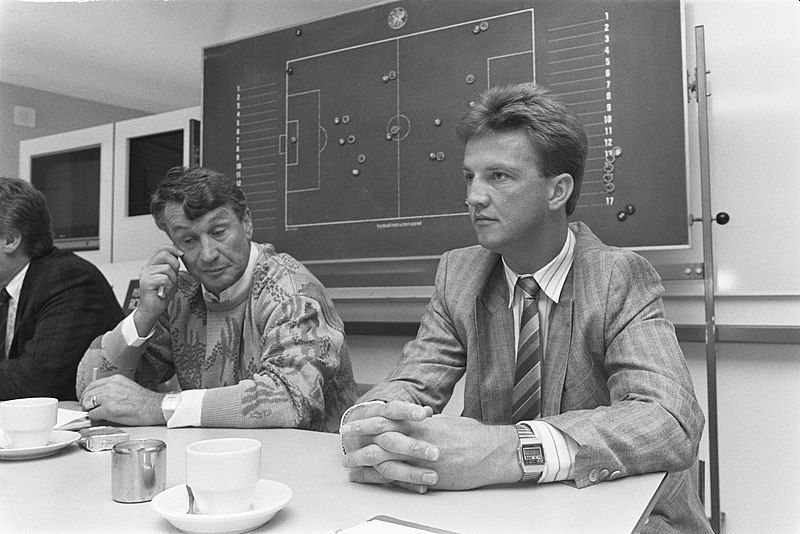
Under his reign they won the UEFA Cup in 1992, with three consecutive titles coming in 1993-1994, 1994-1995 and 1995-1996. It wasn’t just on the domestic front where they enjoyed success, with the 1994-1995 campaign seeing them go unbeaten in the league and Champions League for a superb double.
They won the UEFA Super Cup against Real Zaragoza, having already secured the Intercontinental Cup, and nearly won successive Champions Leagues when they made the final in 1996. Ultimately, though, the match itself ended in a 1-1 draw before Italian side Juventus beat them on penalties.
What followed was a departure of the manager who had seen success return to the club, as well as numerous important players. Even so, Michael Laudrup, the Danish team captain, inspired Ajax to a league and cup double in the 1997-1998 season. That proved to be something of a last hurrah for the club in the league, finishing sixth at the end of the following campaign.
A Fall From Grace
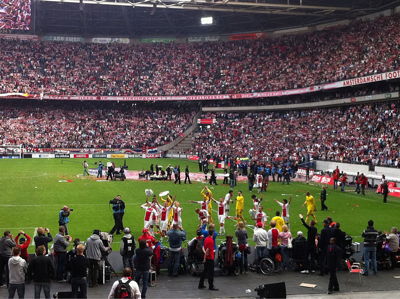
The 2000s proved to be a tricky time for Ajax, with in-fighting and numerous managerial changes causing issues for the club. Titles in 2001-2002 and 2003-2004 alongside cup wins in 2001-2002, 2005-2006 and 2009-2010 kept things ticking over, but they had to wait six years between Eredivisie titles.
Arguably the most significant thing happened in 2010, when Johan Cruyff worked hard to ensure that he could influence the way that Ajax would perform from then on. He put allies in key positions, making sure that his friend Frank de Boer became manager after the resignation of Martin Jol.
In March 2011, the Ajax board resigned en masse due to a refusal to carry out Cruyff’s footballing plan. There was internal strife that included a plan from four supervisors to get Cruyff out of the club by appointing Louis van Gaal as Chief Executive Officer, knowing the pair hated each other. Cruyff ended up taking them to court, winning his case and causing the four supervisors to resign.
Cruyff was effectively in charge of Ajax, allowing him to carry out his plan and setting the policy for Ajax for long-term. The 2010-2011 campaign saw a thrilling finish, with second-place Ajax defeating league leaders Twente on the final day of the season to win the title.
The success continued, including a 2-1 win over Manchester United at Old Trafford in the Champions League. They won title after title, managing to win their fourth consecutive championship for the first time in the club’s history in 2013-2014.
They would meet United again in the 2017 Europa League final, losing 2-0 to the English side whilst playing the youngest side ever in a European final. Marcel Keizer, a former Ajax player, took over as manager for the 2017-2018 season, being just a week into his tenure when tragedy struck the club and the wider world of football.
Abdelhak Nouri was taking part in a pre-season friendly on the eighth of July 2017, having earned his right to play in the first-team by impressing in the Academy. He collapsed on the pitch because of a cardiac arrhythmia. He was taken to a local hospital by air ambulance and his condition was stable, but it was later revealed that he had suffered severe brain damage.
It later emerged that his condition would almost certainly have been better had he been treated with a defibrillator sooner and in 2022 Ajax agreed to pay his family €7.85 million in compensation.
A Return to the European Stage
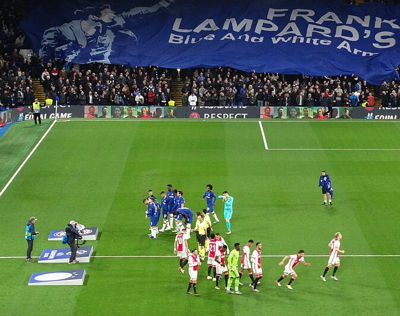
Having failed to qualify for either the Champions League or Europa League group stage in the 2017-2018 season, it was decided that Marcel Keizer would move on. In his place, Erik ten Hag was appointed and helped the club to recover enough to manage a second-place finish.
The following year saw one of the club’s best campaigns of the 2010s, with Ajax making it into the Champions League group stage for the first time since 2014. Not only that but the club defeating Real Madrid, the winner of the previous three Champions Leagues, in the round of 16.
They went on to beat Juventus in the quarter-finals and ended up playing English side Tottenham Hotspur. When Ajax won the first-leg 1-0 it looked as though they would be playing in the final against Barcelona, who had defeated Liverpool 3-0 in their first leg.
The second-legs were amongst the most exciting in the history of the competition, however, with Liverpool winning 4-0 at Anfield and Spurs coming back from an aggregate score of 3-0 down to draw 3-3 and make it through to the final on away goals. Liverpool went on to beat them 2-0 and win the competition for a sixth time.
Ajax’s Stadiums
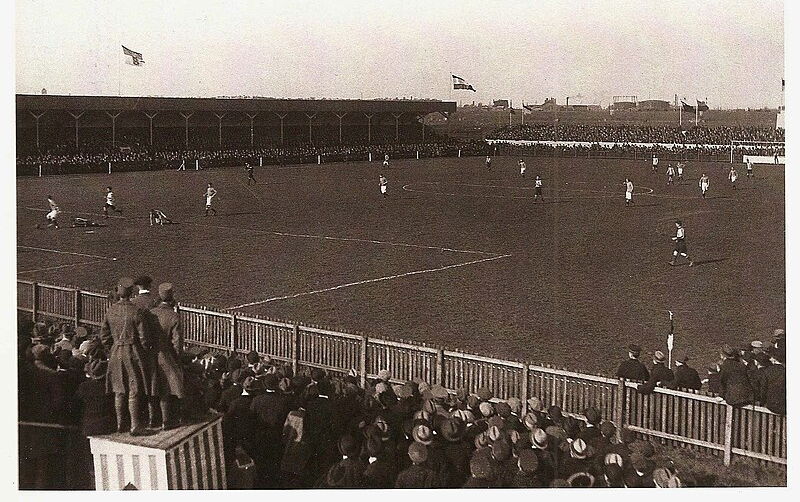
The first stadium that Ajax played football in was made out of wood. The Het Houten Stadion, which translates as ‘wooden stadium’, opened in 1911. When the Olympic Stadium was built to accommodate the Summer Olympics in 1928, Ajax began playing their games there.
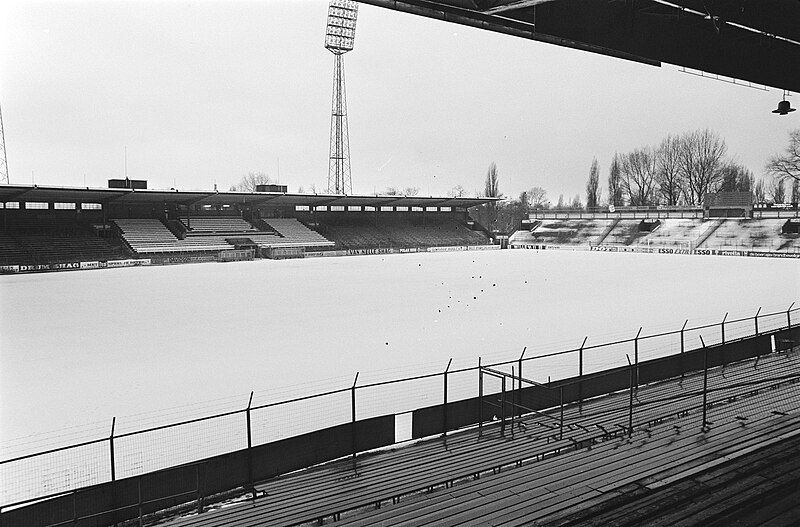
In 1934, Ajax moved to De Meer Stadion, located in East Amsterdam and close to where Het Houten Stadion had been. Designed by Ajax member and architect Daan Roodenburgh, who had designed the wooden stadium, it allowed 29,500 people to get in and watch the club play its football.
Ajax remained there until 1996, which was when a new stadium opened in the Southeast of the city. Amsterdam Arena cost around £130 million to build and was built by the Amsterdam city authority. Capable of hosting nearly 56,000 people, it set the standard for other stadiums around Europe thanks to its retractable roof and excellent sight-lines.
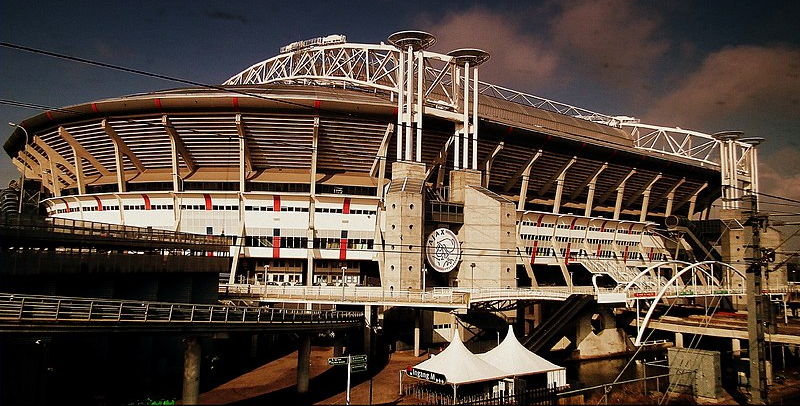
The stadium became known for its awful pitch, owing to the fact that the retractable roof stopped sunlight from getting to the grass; a problem that was mitigated by artificial lighting. It was renamed as the Johan Cruyff Arena in 2018.
The Academy System
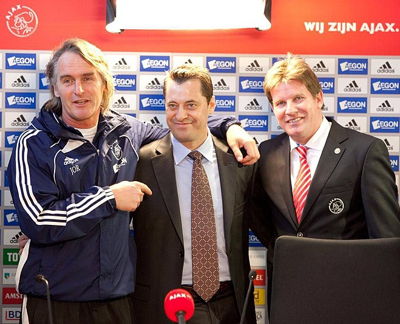
If Ajax is known for one thing other than the Total Football of the 1970s then it is probably the club’s Academy. The names that have emerged from it over the years have managed to cement themselves in the mind of football fans around the world.
Names such as Johan Cruyff, Frank Rijkaard, Dennis Bergkamp, Edwin van der Sar, Patrick Kluivert and Marco van Basten emerged from the ranks of the youth team in order to cement their places in the Ajax team, with many going on to play for other clubs such as Manchester United, Arsenal and Barcelona.
The Ajax Academy has also seen some players signed into it at a young age before working their way through the system. The likes of Jan Vertonghen, Thomas Vermaelen and Toby Alderweireld all made their way through the Ajax youth sides, for example.
The club also moved to set up Academies like Ajax Cape Town and Ajax America to try to find players in untapped markets. Even aside from the players that Ajax’s Academy has produced over the years, it has also influenced the way that other clubs use their youth systems to bring through players and work with others.
Why the Club is Called Ajax Amsterdam
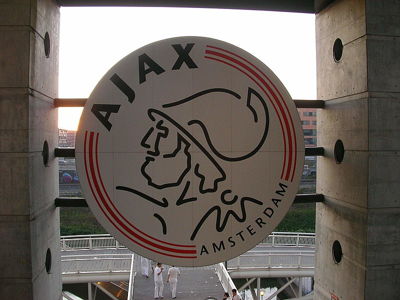
One of the questions that many people ask is why, exactly, the club is called Ajax. It was named in honour of the mythical greek hero Ajax, who fought in the Trojan War against Troy. The name was decided upon by Floris Stempel, Carel Reeser and Han Dade, the founding fathers, who had already tried to name a club Amsterdam Ajax but it had failed to take off.
The reason for the name specifically came about because of the exploits of Ajax in the Trojan War, with the Iliad describing him as the bravest of the soldiers that were fighting; a good reason on its own for the name.
Fighting alongside his cousin, Achilles, he was involved in a battle against Troy’s champion, Hector. According to the myth, Ajax committed suicide. Unlike Achilles, therefore, he died unconquered in a battle.
Given that most football clubs are named after the area in which they play their games, there is something a little charming about Ajax being named after a mythological figure who never got beaten. Of course, the idea of the club self-capitulating might have felt a little too real at certain points over the years when in-fighting got the better of everyone involved.
The Club’s Crest & Colours
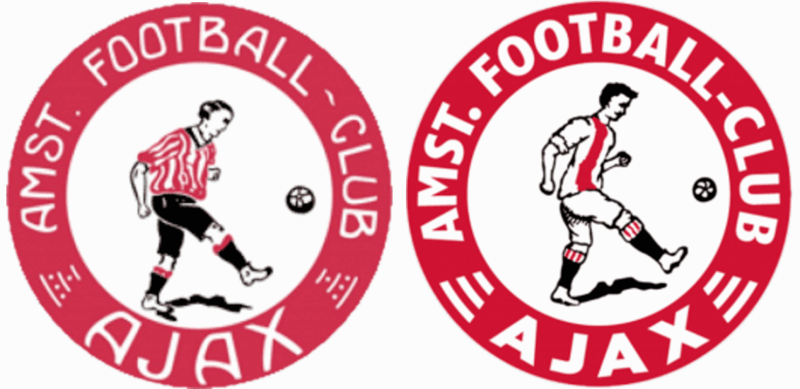
When the club was founded in 1900, the emblem for Ajax was a simple one of a player in black shorts and socks, with a red and white striped top doing keepy-uppies with the ball. When Ajax gained promotion to the top-flight in 1911, there was a need to change kit on account of the fact that another club already played with a similar one. As a result, the shorts became white and the top was mainly white, with a wide red stripe down the centre of it.
That has remained the club’s kit ever since, but the logo that appear’s on Ajax’s badge has changed a couple of times since.
In 1928, it was decided that rather than have a footballer on the badge it should be the head of the mythical warrior after whom the club is named. The head of the Greek hero surrounded by the work ‘AJAX’ became the new logo.
This remained in place for more than 60 years, only changing in 1990 in favour of an abstract version of the previous one.
It is deliberately made up of just 11 lines, which are used to signify the 11 players in a football team, and has remained the club’s crest ever since. Whether another one will be designed to take substitutes into account remains to be seen.
Ajax’s Finances
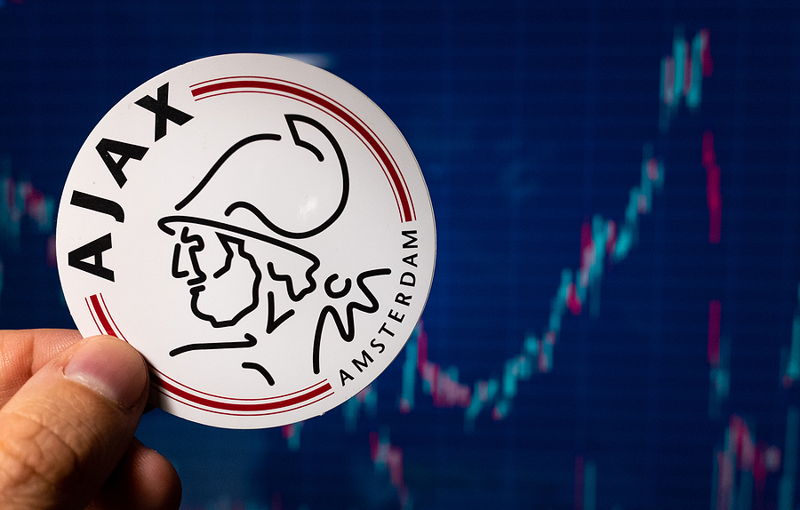
It is worth mentioning the finances of Ajax, largely thanks to the fact that it is the only club in Dutch football that has an Initial Public Offering. It is registered on the Euronext Amsterdam stock exchange as a Naamloze vennootschap, which has been the case since the 17th of May 1998.
The initial price was 25 guilders, with the club bringing its revenue up to a converted figure of €54 million in the first year. The rate dropped after its initial success, going as low as €3.50. There were plenty who criticised the decision to go onto the stock market, feeling it wasn’t right for the club.
The feeling was that there wasn’t a legal grid in place for a football club to operate as a Naamloze vennootschap, meaning that the sports ambitions would suffer as the club chased commercial interests. By 2008, shares of the club were registered at €5.90 each.
Later that year, an honorary member, Uri Coronel, declared that the IPO was not valuable to the club and steps should therefore be taken to exit the stock exchange. The idea was that all public shares should be purchased back, but at the time of writing the club remains on the stock exchange.
Rivalries
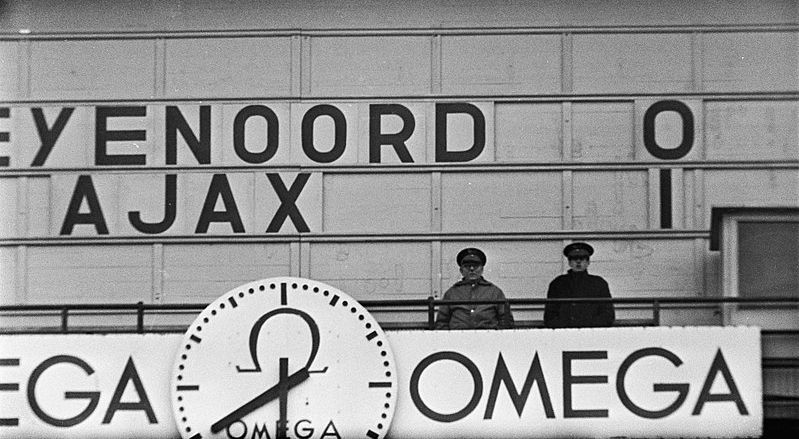
As you might imagine, Ajax’s biggest rivalry has been with clubs that matter because of their geographical location. Feyenoord are based in nearby Rotterdam and the two clubs take part in Der Klassieker each year when they play.
Until the 1973-1974 season, the only clubs in the Netherlands who won the league were Ajax and Feyenoord, furthering the rivalry. Whilst that is the most famous rivalry, it isn’t the only one that Ajax are engaged with. There is beef between Ajax and PSV, for example, especially if the two sides are doing well, with the match between them being known as ‘Der Topper’.
Clubs such as Utrecht, Twente, Vitesse Arnhem and Groningen all have rivalries with Ajax, although the truth is that they dislike the country’s most successful club more than Ajax supporters dislike any of them.
The only possible exception to that is Utrecht, with fans of both sides being banned from attended away matches for five years in 2006 owing to frequently violent clashes between them. Obviously other clubs that are located in Amsterdam are also on Ajax’s list of rivals, such as FC Amsterdam, but no league match has taken place between the sides since it was disbanded in 1982.
Is Ajax a Jewish Club?
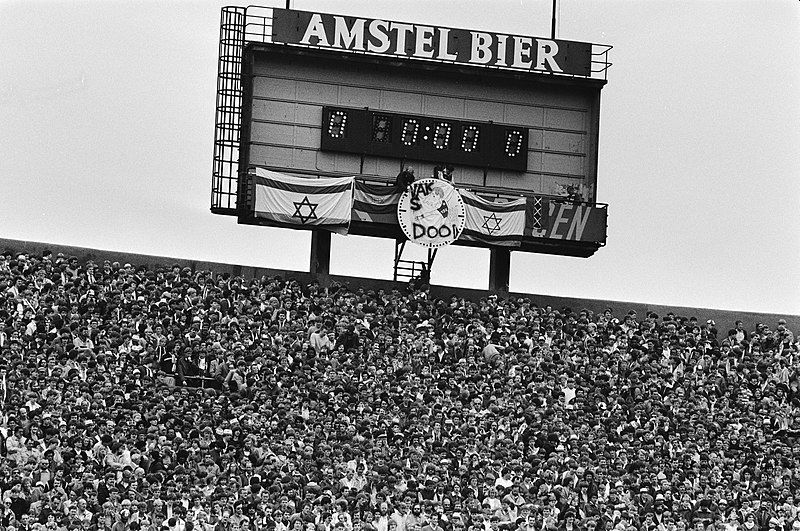
In the 1930s, Ajax’s home stadium was located next to the Jewish quarter of Amsterdam, with opposition fans often seeing Ajax fans walking through the area on their way to matches. In spite of the club that Ajax had fewer Jewish players than WV-HEDW, it became known as a club with strong Jewish links.
Amsterdam as a city was known as a Mokum city, with Mokum being the Yiddish word for ‘safe place’. As a result, anti-semitic chants were often directed at Ajax players, with the club responding by embracing its Jewish image, the fans often calling themselves ‘Super Jews’.
Over the years that followed, the Jewish imagery grew to become an important part of Ajax’s fan culture. The club even had Hebrew folk songs available to download from its website for use as a ringtone, for example. Sadly, opposition fans would often go too far.
The 1980s regularly saw opposition fans doing Nazi salutes when playing Ajax, as well as making hissing sounds as an imitation of the gas chambers. The result was that many Jewish Ajax fans decided to stop going to the games and in the 2000s the club tried to dissuade the fans from being tied to the Jewish imagery.
